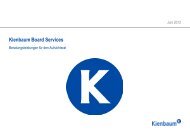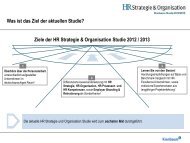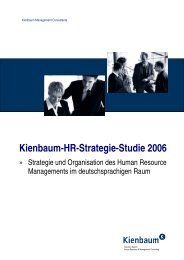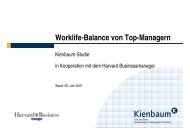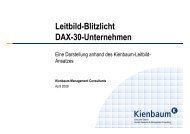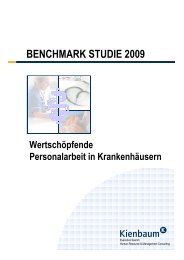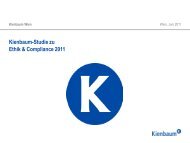Value Based Job Grading (english) - Kienbaum
Value Based Job Grading (english) - Kienbaum
Value Based Job Grading (english) - Kienbaum
You also want an ePaper? Increase the reach of your titles
YUMPU automatically turns print PDFs into web optimized ePapers that Google loves.
<strong>Value</strong> <strong>Based</strong> <strong>Job</strong> <strong>Grading</strong>
<strong>Value</strong> <strong>Based</strong> <strong>Job</strong> <strong>Grading</strong><br />
A value- and performance-based<br />
direction for your company<br />
In a dynamic market environment shaped by restructuring,<br />
integration and performance, there is an ever greater<br />
demand for enhanced interplay between business processes<br />
on the one hand and the organization of structures<br />
and workflows on the other. A forward-looking performancebased<br />
system has to incorporate the entire company.<br />
It also has to be reflected in the compensation system and<br />
take account of the value each function brings to the whole.<br />
Starting point:<br />
Do the levels and steps in the functions reflect the value<br />
they add to the company or are they just illustrations of<br />
who reports to whom?<br />
Do the grading criteria used take account of the contribution<br />
made to the success of the company or do they primarily<br />
reflect such input-based factors as education and<br />
tenure at the company?<br />
Whilst reorganizing, improving processes and<br />
enhancing the compensation system, the following<br />
core questions have to be asked:<br />
» What business processes are critical to success and who<br />
designs and controls performance in these processes?<br />
» What positions deliver significant contributions to<br />
adding value to the company?<br />
<strong>Job</strong> <strong>Grading</strong><br />
Human Resource Management<br />
2
The <strong>Kienbaum</strong> Approach:<br />
The entire contribution made by the job position<br />
to the success of the business and to adding value is<br />
gauged on the basis of the following questions:<br />
» What contribution does the position make to the<br />
decision-making and to the development of group/<br />
corporate strategy?<br />
» What contribution does the position make to controlling<br />
and enhancing value drivers?<br />
Core criteria<br />
Effect on<br />
strategy?<br />
Effect of<br />
value drivers?<br />
Effect on<br />
processes?<br />
<strong>Grading</strong> of positions<br />
Output/value base<br />
Stronger link to processes<br />
Additional criteria<br />
Management and<br />
control effect?<br />
Communications<br />
effect?<br />
Link to organization and management structures<br />
High level of objectivity and clarity<br />
High level of transparency and communicability<br />
Definition of the level and grading of functions in terms<br />
of their strategic significance and their contribution to<br />
business processes as well as the share they have in adding<br />
value to the company<br />
» What contribution does the position make to designing<br />
and controlling business sectors and processes?<br />
» What is the dimension of the management and control<br />
tasks entrusted to the position in the organization?<br />
» What is the specific effect the position has in<br />
communications?<br />
<strong>Job</strong> <strong>Grading</strong><br />
Human Resource Management<br />
3
Project Steps<br />
A typical grading project encompasses the following<br />
steps:<br />
» System calibration:<br />
Adaptation of the system to the client’s business model<br />
» Process and organizational analysis:<br />
Inclusion and cataloging of business processes and the<br />
organization<br />
» Selection of reference functions:<br />
Selection of suitable reference functions so that the<br />
range of functions in the company can be illustrated<br />
» Position analysis:<br />
Analysis of reference functions using job descriptions<br />
and interviews as a basis for grading<br />
» <strong>Grading</strong> of positions:<br />
Tool-aided grading of reference functions based on<br />
<strong>Kienbaum</strong> criteria<br />
» Definition of management spheres and allocation of<br />
functions<br />
» If required, implementation in process and structural<br />
organization<br />
» Layout including salary ranges<br />
» If required, development of specified competence<br />
management instruments<br />
» Know-how transfer to the organization for further use<br />
in the company on its own<br />
Sample grading of a position<br />
1 Effect on strategy 1<br />
2 <strong>Value</strong> driver level 2<br />
3 Effect on process 3<br />
4 Process level and value 1<br />
5 Leadership and control 2<br />
6 Effect on communication 1<br />
<strong>Job</strong> <strong>Grading</strong><br />
Point value<br />
Human Resource Management<br />
4
Project results<br />
A close link to your business resulting from support<br />
through value and process management:<br />
» Identifying the effect of positions on value drivers<br />
in the company<br />
» Identifying the role of positions in association with<br />
business processes<br />
» Identifying redundancies in the perception of work<br />
functions, possible deficits in control and a lack of roles<br />
in processes critical to success<br />
» participates in setting strategy<br />
» has a significant value driving effect<br />
» designs the most important business processes<br />
» designs and controls important business processes<br />
and thus has an effect on value drivers<br />
» has significant control functions in business<br />
operations and influences process performance<br />
» …<br />
Significance of positions based on value<br />
» <strong>Job</strong> grading demarcates the various spheres of<br />
management<br />
» <strong>Job</strong> grading is the basis for defining salary bands<br />
» A realignment of management echelons and a restructuring<br />
of management titles based on the contributions<br />
they make to value and the role they play in company<br />
processes<br />
» A basis for competence management geared to value<br />
levers and process-specific roles<br />
» Harmonization of the organization, HRM instruments<br />
and the compensation system<br />
Level IV<br />
Level III<br />
Level II<br />
Level I<br />
<strong>Job</strong> <strong>Grading</strong><br />
Human Resource Management<br />
5
<strong>Kienbaum</strong> Management Consultants GmbH<br />
Human Resource Management<br />
Beethovenstraße 12-16<br />
60325 Frankfurt am Main<br />
Tel. +49 (069) 742 237 00<br />
Fax +49 (069) 742 237 02<br />
grading@kienbaum.com<br />
Why <strong>Kienbaum</strong>?<br />
» We listen to you before we do anything<br />
Our first job as your partner is to gain an insight into your<br />
company. Taking account of your objectives and your living<br />
corporate culture, we then develop solutions relevant to the<br />
value- and performance-based direction your company takes.<br />
An essential part of our work is listening carefully and attentively<br />
to you first.<br />
» We accompany you until you’ve achieved your goals<br />
We recognize possible solutions and work together with you<br />
to achieve them. We also back you up when it comes to<br />
implementing solutions that will help you reach your goals.<br />
We enjoy supporting you in implementing each practical<br />
step.<br />
» We make our entire system available to you<br />
We transfer our system know-how to you and thus give you<br />
a flexible IT tool you can use to grade other functions and<br />
adapt such grading to any circumstances that may occur in<br />
the future. You can then work on these circumstances without<br />
any further consulting work necessary.<br />
» We develop solutions that meet with approval<br />
Your staff is your company’s greatest asset. We design and<br />
implement solutions that will meet with your management’s<br />
and your staff’s approval. Our work is successful when we are<br />
all convinced of the result. A persuasive result for us is made<br />
up of flexible systems that will work for you in the long term<br />
and can be easily adapted to meet future challenges.<br />
We actively support you whilst communicating changes.




